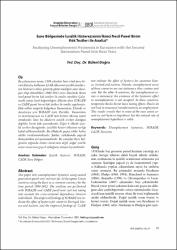Euro Bölgesinde İşsizlik Histerezisinin İkinci Nesil Panel Birim Kök Testleri ile Analizi
Özet
Bu çalışmanın amacı 1999 yılından beri ortak para birimi Euroyu kullanan 12 AB ülkesinin işsizlik oranlarının histerezis etkisi gösterip göstermediğini yani durağan olup olmadıkları 1980-2012 arası dönemde ikinci nesil panel birim kök testleri ile analiz etmektir. Çalışmada yatay kesit bağımlılığını dikkate alan SURADF ve CADF panel birim kök testleri ile analiz yapılmıştır. Elde edilen ampirik bulgulara Yunanistan, İrlanda ve Avusturya için SURADF testi; Portekiz, Yunanistan ve Avusturya için ise CADF testi histeri etkisine işaret etmektedir. Yani bu ülkelerin işsizlik serileri durağan değildir, birim kök içermektedir. Diğer 9 ülkede işsizlik serileri durağandır, işsizlikte histeri etkisinin varlığı kabul edilmemektedir. Bu ülkelerde geçici şoklar kalıcı etkiler bırakmamaktadır. Şoklar, istihdamda yapısal dönüşümlere yol açmamaktadır. Bu sonuçlar Euro bölgesinin çoğunda histeri önsavının değil, doğal işsizlik oranı önsavının geçerli olduğunu ortaya koymaktadır. This paper tests unemployment hysteresis using second generation panel unit root tests for 12 European Union countries using the Euro as a common currency for the time period 1999-2012. The analyzes are performed with SURADF and CADF panel unit root test taking into account the cross-sectional dependence between individuals. The empirical findings of SURADF test indicate the effect of hysteria for countries Portugal, Greece and Austria, and the empirical findings of CADF test indicate the effect of hysteria for countries Greece, Ireland and Austria. Namely, unemployment series of these countries are not stationary, they contain unit root. For the other 9 countries, the unemployment series is stationary; the existence of the hysteresis effect in unemployment is not accepted. In these countries, temporary shocks do not leave lasting effects. Shocks do not lead to structural transformations on employment. This results reveals that in most of the euro zone’s countries, not hysteria hypothesis but the natural rate of unemployment hypothesis is valid.
Kaynak
Anadolu Üniversitesi Sosyal Bilimler DergisiBağlantı
https://hdl.handle.net/11421/1621Koleksiyonlar
- Cilt.14 Sayı.3 [12]


















